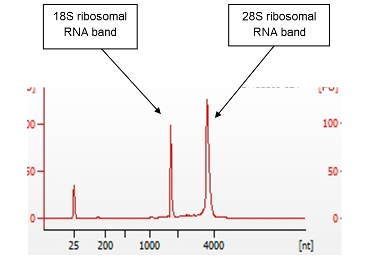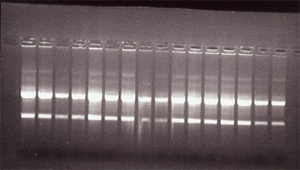ECACC Nucleic Acids
- Cell lines: important tools for elucidating the role of genes in disease and therapeutics
- Ready-to-assay nucleic acids from cell lines for appropriate model choice
- Genomic DNA from cell lines
- Quality control for cell line DNA
- Human Random Control DNA Panels
- How to handle cell line DNA on arrival
- RNA from cell lines
- Summary of typical quality scores for RNA prepared by ECACC using ECACC cell lines
- cDNA from cell lines
- Process for creation of cDNA from ECACC cell lines
- Advantages of obtaining corresponding nucleic acids from ECACC

Genetic researchers study the role that genes and their variants play in disease, and are working to identify the genetic and environmental causes of common illnesses. The results of such studies will lead to advances in disease prevention and treatment. Pharmaceutical innovations are often identified based on our increased understanding of genes; these newer drugs can target focused sites in the body, and may therefore have fewer side effects than more traditional medicines. Moreover, the promise of personalized medicine will require tools for exploring an individual's unique genetic profile. Cell lines are convenient models that can facilitate these studies, but their relevance to the biological systems they are meant to model must be verifiable.
Ready-to-assay nucleic acids from cell lines for appropriate model choice
In order to be appropriate models for biological systems, cell lines must be physiologically relevant, and be probed for expression of gene(s) of interest. We have partnered with The European Collection of Authenticated Cell Cultures (ECACC), a part of Public Health England, to provide genomic DNA, RNA and cDNA from most ECACC cell lines to help researchers select the most suitable cell model for their studies. ECACC cell line-derived nucleic acids provide a genomic and transcriptomic snapshot of their corresponding cell line, which can be used to screen lines for genes, expression patterns, or the presence of interesting biomarkers using cost-effective PCR-based methods before deciding to utilize more costly protein-based assays.
Genomic DNA, RNA and cDNA formats are available as standard items on each cell line product page. We additionally provide a range of Human Random Control DNA panels. These comprise 96 control DNA samples (2 mg of DNA at a concentration of 100 ng/mL) supplied in a 96-well plate. Five different panels are available.
Genomic DNA from cell lines
We offer high quality, high molecular weight genomic DNA extracted from ECACC cell lines. To ensure the highest quality and reproducibility, extracted DNA is subjected to defined quality control procedures, and all ECACC DNA products are supplied at a standard concentration of 100 ng/μL in 5 µg per tube.
Genomic DNA is extracted from cell lines using an automated extraction system employing silica-coated magnetic bead technology. All DNA is quantified using the A260 absorbance assay and normalized to a standard concentration of 100 ng/µL.
Quality control for cell line DNA
To ensure the highest quality, all ECACC DNA products are subjected to defined quality control procedures which include assays for:
- DNA Size and Integrity: Agarose gel electrophoresis is used to verify the molecular weight and integrity of cell line DNA. Our extraction procedure consistently produces genomic DNA between 20-30 kb in size.
- Purity: 260/280 nm and 230/260 nm UV spectrophotometry ratios are used to determine purity of the extracted DNA
- Authenticity: Short tandem repeat (STR) PCR, using a commercially available forensic kit consisting of 10 markers plus amelogenin (a marker for gender determination), is used to verify the identity of each batch of DNA against source material.
Human Random Control DNA Panels
Human Random Control (HRC) DNA is a readily available, cost-effective, and renewable source of authenticated, high quality purified genomic DNA from a control population of 480 randomly selected, non-related UK Caucasian blood donors. DNA is extracted from lymphoblastoid cell lines from single donor blood samples derived by EBV (Epstein-Barr virus) transformation of peripheral blood lymphocytes and is available as a series of five panels. Each panel contains samples from 96 unique individuals in a convenient 96-well format. DNA is provided at a concentration of 100 ng/μL in 10 mM Tris buffer (pH 8.0) with 1mM EDTA. Gender and age at blood collection is available for most samples.
How to handle cell line DNA on arrival
Frozen DNA products should be stored at -20 °C upon receipt if they are not used immediately. Repeated freeze/thawing should be avoided. On receipt of your DNA order, ECACC recommends the following:
DNA supplied in tubes
- Once thawed, the DNA can be stored at 4 °C to 8 °C for at least six months
- Before removing the cap, place the tube in a mini-centrifuge for a short spin to bring contents to the bottom of the tube
- To prevent cross-contamination, take care not to mix caps between samples. If in doubt, use a fresh cap.
DNA supplied in 96-well plates
- Once the plates have been thawed, and prior to piercing the seal, they should be centrifuged briefly to bring all contents to the bottom of the plate wells
- DNA supplied in 96-well plates is intended for single use. However, should it be necessary to store the plates, the plastic lid should be placed over the pierced wells. The plate should be stored upright at 4 °C to 8 °C. The DNA will evaporate rapidly if the plate is not re-sealed using the included replacement seal. When resealed, the DNA can be stored for at least three months at 4 °C to 8 °C.
- ECACC does not recommend refreezing the plates.
RNA from cell lines
We offer high quality RNA prepared from ECACC cell lines. All RNA is quantified using a Nanodrop N1000 spectrophotometer and normalized to a standard concentration of 100 ng/µL. As part of our routine Quality Assurance, a proportion of each batch of RNA is tested for purity using the nucleic acid 260:280 and 260:230 absorbance ratios. RNA size and integrity are measured using agarose gel electrophoresis. RNA is provided in a 5 μg pack size at a concentration of 100 ng/μL.

Agilent Electropherogram showing RNA extracted from an ECACC Cell line. RIN score for this sample was 9.9

Gel electrophoresis of 16 of the RNA samples from ECACC cell lines showing un-degraded RNA with strong 28S ribosomal bands.
Summary of typical quality scores for RNA prepared by ECACC using ECACC cell lines |
|---|
cDNA from cell lines
cDNA (complementary DNA) provides a cost-effective reagent for screening cell lines for gene expression characteristics. This enables selection of the most relevant cell lines for meaningful modeling of biological and disease systems. Researchers can source stable cDNA for pre-screening transcriptomes for expression characteristics.
Process for creation of cDNA from ECACC cell lines
ECACC scientists use high quality RNA—with RNA Integrity Numbers (RIN) typically above 9.7— to generate cDNA from our diverse range of cell lines. 1-2 x 106 cells are harvested from ECACC cell lines during the log phase of growth, and the RNA extracted before reverse transcription is used to generate single stranded cDNA. Extracted RNA is confirmed to be free of degradation using gel electrophoresis, and the presence of genomic DNA is assessed using PCR primers that recognize intronic sequences. To validate cDNA, PCR is performed using β-actin primers specific for cDNA. These primers do not recognize processed pseudogenes, or intronless copies of the gene within the genome. All cell banks from which cDNA is generated are fully-authenticated and maintained with rigorous process protocols to ensure quality and traceability.
As it’s not possible to quantify total cDNA, ECACC offers a standard single aliquot consisting of 20 µL of cDNA in a 2 mL tube. cDNA is prepared from RNA extracted from cell lines (at log phase growth) and supplied in a 20 µL volume per tube. cDNA should be stored at -80 °C when not in use; we recommend making aliquots of the cDNA after the initial thaw so that repeat freezing and thawing may be avoided.
Advantages of obtaining corresponding nucleic acids from ECACC

- Permits confirmation of gene expression corresponding to relevant proteins in cell line models before you purchase
- Eliminating the need to culture cell lines, extract RNA, and generate cDNA in order to obtain necessary genetic and expression profiles results in significant time savings
- Authenticated, quality nucleic acids are available in the appropriate format, ready to use in downstream screening
Agaorose gel electrophoresis of RT-PCR products after RNA extraction and 11st strand cDNA synthesis
Lane 1 — 100bp ladder
Lane 2 — β-actin primers
Lane 3 — NPCC primers
Lane 4 — HMsH2 primers
Lane 5 — XRCC1 primers
Lane 6 — ERCC1 primers
Lane 7 — INRP primers (for gDNA)
Lane 8 — +ve control
Lane 9 — -ve control
Figure 1 (left). The absence of carryover from ECACC cell line genomic DNA is confirmed by using corresponding RNA in a PCR reaction with PCR primers designed to amplify the intronic sequences of a standard, constitutively expressed housekeeping gene. 1 µg of RNA was used as template in a first strand cDNA synthesis reaction using the Qiagen Omniscript® cDNA synthesis kit. Reaction was primed with an anchored oligo dT primer for maximal synthesis of gene sequences. The presence of cDNA was then confirmed by using the cDNA as a template in a PCR reaction with primers that detect exclusively human cDNA sequences, without coamplification of pseudogenes.
All nucleic acid products for ECACC cell lines in genomic DNA, RNA and cDNA formats are available on the corresponding cell line web page.
如要继续阅读,请登录或创建帐户。
暂无帐户?